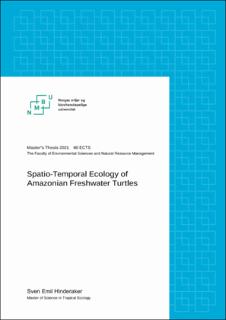| dc.description.abstract | Amazonian freshwater turtles are a key component of the Amazonian waterscape and an important resource for riverine communities. However, extensive exploitation combined with habitat alteration and climate change has endangered the giant South American river turtle (Podocnemis expansa) and the yellow-spotted river turtle (Podocnemis unifilis), two of the largest freshwater species in the region, reducing their numbers to only a fraction of pre-colonial levels. The survival of these species is therefore dependent on successful conservation efforts. For conservation to be successful, knowledge on where and when animals spend their time is necessary in order to successfully implement appropriate actions. However, little is known about the spatial ecology of Amazonian river turtles. To obtain information on spatio-temporal movement patterns and habitat use, 7 individuals of P. expansa and 3 P. unifilis were tracked in the central Juruá River region of the Brazilian Amazon using ARGOS satellite transmitters from 2011 to 2016. Space-use varied widely within and between the two species. P. expansa has a considerably larger home range than P. unifilis with a mean of 74,881 (±81,453 SD) hectares compared to 31,167 (±27,550 SD) ha, respectively. Both species show a high affinity to the main river, but P. expansa use the flooded forest and oxbow lakes to a larger degree than P. unifilis. After nesting at seasonally exposed beaches in August-September, P. unifilis moves into the surrounding flooded várzea forest as the water level starts to rise. P. expansa, nesting a month later, generally started moving at the end of November and early December. Upon leaving the nesting site, P. expansa leaves the river and moves into the forest until it returns when the water level drops rapidly in June. P. unifilis appears to move the furthest away from the river in November, towards oxbow lakes in the forest. Conservation of nesting beaches and the surrounding areas will continue to be important due to high site fidelity among the turtles. However, community-based protection along the river during seasonal movements and of flooded forests during high-water could improve survival and reproduction of P. expansa, within and outside protected areas, while the area around the nesting beach is a key habitat for P. unifilis. | en_US |

